Day 1... We left
Wollongong
NSW at 7:00 a.m. and arrived in
Mildura Victoria
at around 8:30 pm. This run is about 960km. We Visited our son/stepson, Daryl,
his wife Melissa and our two grandchildren, Courtney and Mitchell. We spent
several days there and then headed on to
Port
Augusta, about 650 km away in South Australia. The first of our problems
occurred there - the 12 volt battery that runs the water pump for the kitchen
tap and the interior lights in the trailer packed it in. We had to amend our
plans to rough camp, as it would be too rough without lights during the early
sunsets of winter. So we tried to stay in caravan parks with powered sites
until the battery could be replaced.
We stayed in a great
van park 5 km off Horrocks Pass Road and 25km SE of the city of Port Augusta.
Spear Creek is set in bush
land tucked into the side of the mountain. The sites were shady and the camp
kitchen was good. (Often, if we are in a place for a short time, we prefer to
use their facilities for cooking instead of dragging the barbecue out from
under the bed or cooking inside.) Best of all there was a huge campfire and a
friendly group who expressed disappointment that we were only there for the
one
Next morning we headed
into Port Augusta. Our stay in Port Augusta was short, only giving us time to
visit the fascinating Wadlata Outback
Centre and the cold and windy,
Arid Botanic
Gardens.
And so just after
lunch we began the 2730 km run north from Port Augusta to Darwin.
Woomera, about 182 km north of Port
Augusta was our first stop, and is the rocket capital of Australia. We had
just learned that
NASA will again be using the facilities there. The caravan park there was
by far the worst Caravan Park of the whole trip. It was cold, bare, and
subject to traffic noises, but it did have a great camp kitchen. In the dark
without power it was the best option for meal preparation. powered sites were
booked out and it was the only Van Park on the whole trip where we were told
"you should have booked 3 months in advance"). The rockets on display and the
visitor’s centre in town were worth a visit.
Next day we made for
Coober Pedy,
travelling 252 Km of practically nothing. One of the few things to see was the
sign just before the Glendambo
Road House.
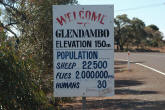 |
|
Glendambo road sign |
Coober Pedy is a centre of opal mining
and we stayed there a few nights, visiting underground churches, houses, and
shops (because of the heat), then we took a bus trip to the opal fields, a
golf course totally without grass, the dog fence and the Breakaways. After
the bus trip we took our 4WD back along the dog fence, and out to The
Breakaways to watch the colours change and to photograph the sunset.
No trip to Coober Pedy would be complete
without a visit to Crocodile Harry's underground home. Crocodile Harry is a
real character who had many careers during his working life. He became a
photographer after moving to Coober Pedy, and advertised in the Adelaide
papers for beautiful young women to be photographed nude. He boasts that he
slept with most of them. To prove his point he had each of them leave their
underwear, which adorns his walls and ceilings. Harry now makes a few dollars
from the tourists who are charged $1 per head to have a look around his home.
 |
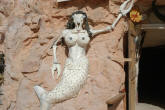 |
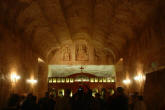 |
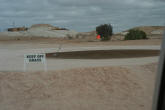 |
|
The Dog Fence |
The Mermaid at
Crocodile Harry's
underground home
|
Underground
Greek Orthodox Church |
One of the "Greens" at the
Coober Pedy Golf Course
The greens are oiled sand |
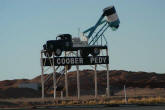 |
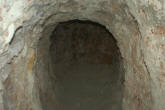 |
 |
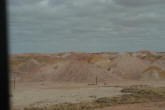 |
|
The Coober Pedy Sign
|
An Opal Mine Shaft
|
A vertical Mine Shaft |
Opal Mine Tailings
|
The desert landscape around The
Breakaways is much like the American west with its spectacular mesa's, buttes
and hills. Unfortunately the clouds had rolled in and the sunset was quite
disappointing.
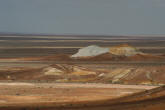 |
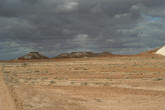 |
 |
 |
Pepper & Salt Hills
The Breakaways |
The Breakaways
|
The Breakaways |
Stone Art in
The Breakaways |
On the second morning
there was a heavy fog over the whole area of Coober Pedy, which the locals
said they haven’t seen for many years. We stayed at the
Stuart Range Caravan
Park, which was pretty good except for the bloody noisy rooster who had
decided that dawn started at about 2:30 a.m. Coober Pedy has to pipe all of
their water in and so you have to pay for showers and to fill your water tank
(although the cost was minimal).
In Coober Pedy, there
was no suitable battery to be found, so we headed north to the next big
centre, Alice Springs, two easy days’ journey away or about 690km. The first
overnight stay on this leg was at
Cadney Homestead. This is a roadhouse and Caravan Park on the Stuart
Highway and is a good base from which to access the
Painted
Desert.
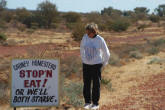 |
|
The sign as you come into Cadney Homestead |
We had originally
planned to stay at the Copper Hills Station, which is some 30 or 40km along
the dirt road into the Painted Desert, but when we arrived we found that it
was closed and had a For Sale sign out the front. The gates were locked and
there was no sign of life. There was no option but to return to the Cadney
Roadhouse. On the dirt road to Copper Hills, some of the welds broke on the
bike racks that I had attached to the top of the camper trailer, (my welding
is like the proverbial bird sh*t on a wire fence) so when we arrived at Cadney
Homestead I had to screw the brackets on with self drilling screws. Luckily I
had brought my cordless drill in the tool kit.
On our travels, we
found that homesteads and roadhouses have reasonable camping, but non-existent
cooking facilities. You are expected to buy your meal at their restaurant.
This meant that I had to get the BBQ out to cook our dinner.
Early the next day, we sidetracked to the Painted Desert, 60
or so km up a dirt road toward the Oodnadatta Track. We spent the morning
there walking. It was breath-takingly beautiful. The photo's below don't
really do justice to the area.
|
|
|
|
|
|
Greg in the Painted Desert
|
The Painted Desert
|
The Painted Desert
|
The Painted Desert
|
After a half day in
The Painted Desert we headed back towards Cadney Homestead but instead of
stopping we turned right and headed towards the Northern Territory/South
Australia border.
Our next stop was
Kulgera, a non- descript roadhouse, but handy and fairly spacious. We stayed
the one night and headed off after a leisurely breakfast.
We finally arrived in
Alice Springs where I was able
to locate a suitable battery. We stayed at the
Heavitree
Gap Caravan Park, where in the early evening the Black Footed Wallabies
come down to be fed by the tourists.